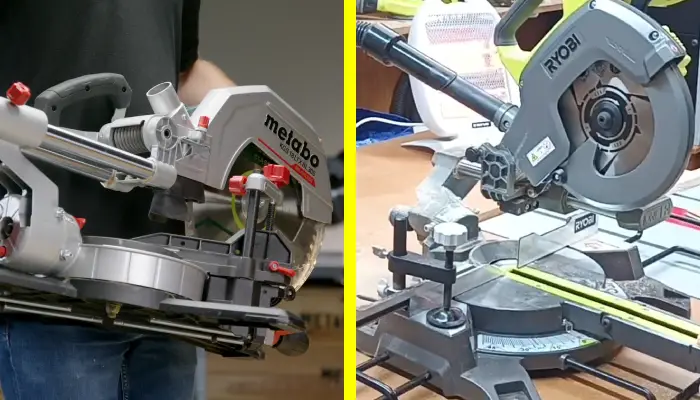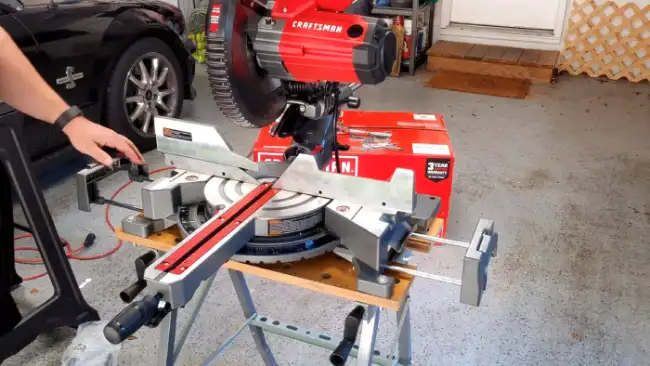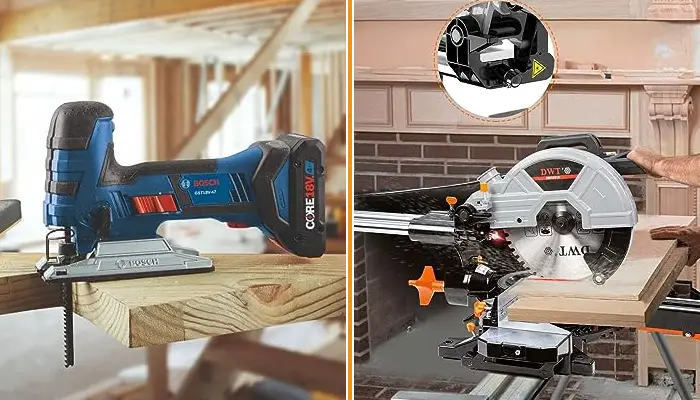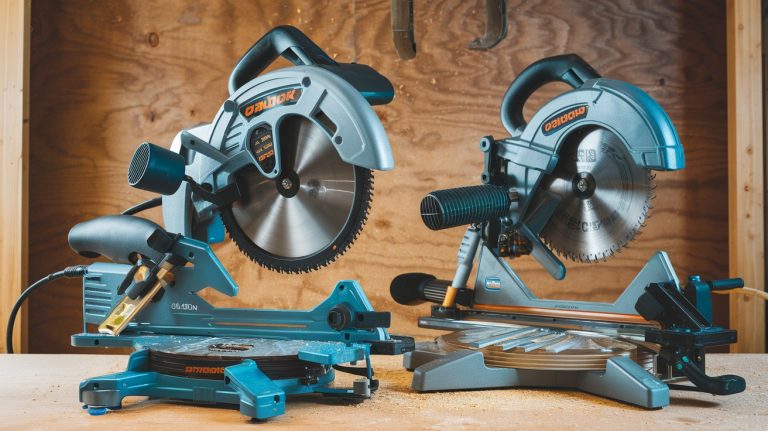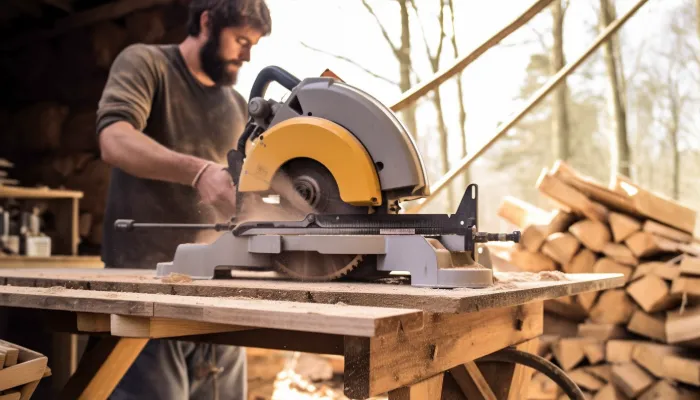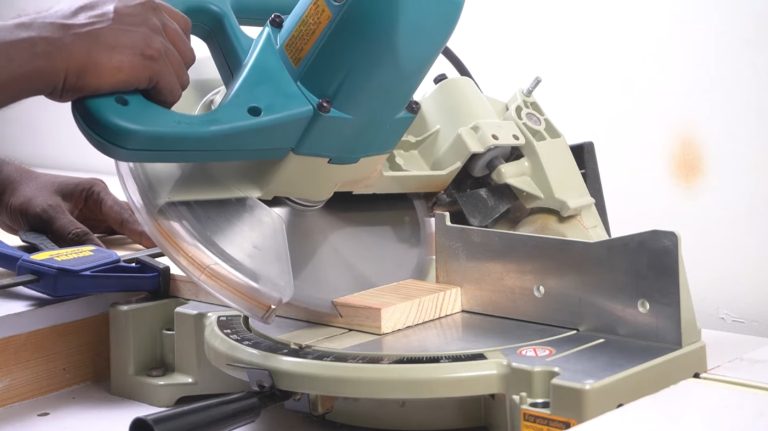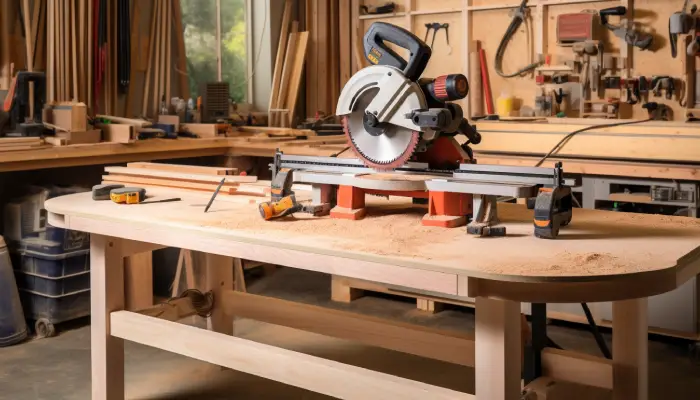Metabo vs Ryobi Miter Saw: 9 Key Differences You Should Know
Miter saws are essential tools for woodworkers, but choosing the right one can be difficult. Metabo and Ryobi are two popular brands on the market, each offering unique features to cut precise cut lines, but their products differ in several ways
Metabo miter saws have higher motor power, providing smoother and faster cuts, whereas Ryobi miter saws have less powerful motors, so they might not match Metabo. Also, Metabo miter saws offer a broader range of cutting angles and higher cutting capacity, allowing for more precise cuts than Ryobi.
In this in-depth comparison, we’ll discuss the key differences between these saw brands, helping you make an informed decision. Whether you’re a professional woodworker or a DIY enthusiast, keep reading to discover which brand suits your needs better.
Metabo vs Ryobi Miter Saws: Key Differences to Consider
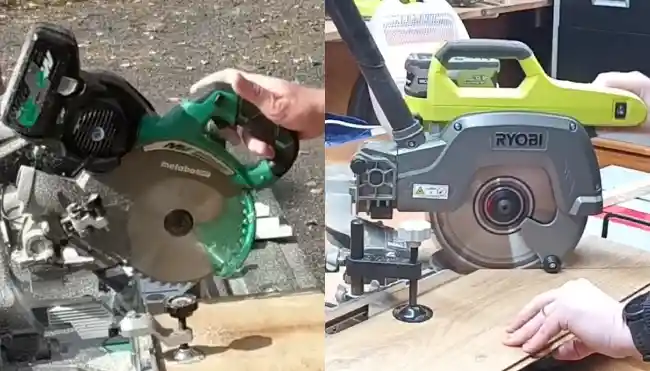
When comparing Metabo and Ryobi miter saws, various key differences exist, such as:
- Motor power
- Cutting angles and capacity
- Dust collection port
- Weight and portability
- Precision and adjustability
- Blade size
- Suitability for projects
- Safety features
- Price point
Let’s look more closely at these differences:
1. Motor Power
You’ll notice that Metabo miter saws have higher motor power than Ryobi miter saws. These miter saws typically have powerful 15 Amp motors, boasting higher amperage. This means that they can cut through dense materials with ease.
Conversely, Ryobi miter saws usually have motors ranging from 10 to 14 Amps. While efficient, they may not match the sheer motor power of Metabo. The higher motor power of Metabo miter saws allows for smoother and faster cuts, especially when working with tougher materials.
2. Cutting Angles and Capacity
With a wider selection of cutting angles and greater cutting capacity, you can handle a wider variety of woodworking tasks using the Metabo miter saw.
Unlike the Ryobi miter saw, which offers limited cutting angles of 0º, 15º, 22.5º, 31.6º, and 45º, the Metabo miter saw allows you to make precise cuts at angles ranging from 0 to 52°, both to the right and left.
This increased versatility opens up a new world of possibilities for your woodworking projects.
3. Dust Collection Port
Enjoy cleaner air and a tidier workspace with the superior dust collection system of the Metabo miter saw. It features a 2.5′ dust port, much larger than the Ryobi miter saw’s 1-1/4 in dust port.
The larger dust port size of the Metabo allows for a more efficient collection of dust and debris. This results in a cleaner work environment and improved air quality.
4. Weight and Portability
Regarding weight and portability, Ryobi miter saws are generally lighter and easier to transport than their bulkier counterparts. This is because Ryobi models are designed with a focus on mobility and maneuverability.
The lighter weight of the Ryobi miter saws makes them more convenient for moving around the workspace, especially if you need to transport them between job sites.
Alternatively, Metabo miter saws tend to be bulkier due to their larger motor size, which makes them better suited for stationary use.
5. Precision and Adjustability
Metabo miter saws are renowned for their accuracy and adjustable bases, ensuring your cutting angles’ accuracy. You’ll appreciate the precise cutting angles and ability to execute intricate curved cuts when using a Metabo miter saw.
Also, the adjustable bases offer flexibility and versatility, allowing you to tackle a wide range of cutting tasks. With these saws, you can easily make precise bevel cuts and adjust the blade tilt to accommodate various cutting needs.
However, the confidence of using a Ryobi miter saw is invaluable, as it enables you to work with intricate curves and achieve flawless results. Whether you’re a professional or a DIY enthusiast, the precision and adjustability of Ryobi miter saws make them a top choice for any small cutting project.
6. Blade Size
Metabo offers a range of blade sizes from 8 to 12 inches, while Ryobi provides options between 10 to 12 inches. The size of the blade plays a crucial role in determining the saw’s cutting capacity.
With a larger blade, you can cut through thicker materials with ease. Also, a larger blade allows for longer cuts, making it ideal for projects that require extended reach.
7. Suitability for Projects
The Metabo miter saw is ideal for heavy-duty projects and demanding cuts due to its durability and capability to handle tough materials with powerful motors. With its robust construction and powerful motor, the Metabo miter saw can easily tackle even the toughest jobs.
Conversely, Ryobi miter saws are better suited for lighter-duty tasks and DIY enthusiasts. While they may not have the same power level as the Metabo, they still offer reliable performance for smaller projects.
8. Safety Features
Metabo miter saws have an edge in this aspect, as they come equipped with overload protection systems. These systems are designed to prevent the motor from overheating and potentially causing damage or harm. They also provide an extra layer of security with a locking mechanism.
On the other hand, some of the Ryobi miter saws may not have this specific locking safety feature. Although both brands prioritize user safety, Metabo’s inclusion of overload protection systems makes it a worthy choice for those seeking enhanced safety during their woodworking projects.
9. Price Point
Regarding price, Metabo miter saws are known for their premium quality and durability. They’re designed for serious woodworkers willing to invest in a high-performance tool. The higher price of Metabo miter saws is justified by their advanced features, precision, and reliability.
Meanwhile, Ryobi miter saws offer a more affordable option without compromising functionality. They’re suitable for beginners or DIY enthusiasts looking for a reliable miter saw that won’t break the bank.
What to Consider When Choosing a Miter Saw Between Metabo & Ryobi?
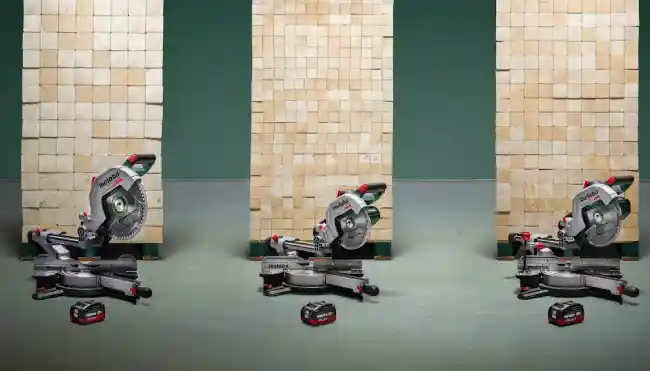
Several key factors must be considered when choosing a miter saw between Metabo and Ryobi.
Types of Miter Saws
You can choose from three types of miter saws from these brands: stationary compound, sliding compound, and sliding dual compound.
- A stationary compound miter saw allows you to make miter cuts to the right and left, but bevel cuts can only be made in one direction.
- The sliding compound miter saw offers the added advantage of moving forward and back along rails, which increases crosscut capacity. This type of saw is perfect for larger projects that require wider cuts.
- Finally, the sliding dual compound miter saw provides the most versatility as it can make bevel cuts to both the right and left and other cuts. This type of saw is ideal for professional woodworkers or those who require precise and intricate cuts.
Blade Size and Crosscut Capacity
Opt for a miter saw with a larger blade diameter (such as Metabo) that matches your table saw to ensure a longer cut capacity. For instance, a 12-inch Metabo saw blade can typically cut through thicker materials than a 10-inch Ryobi blade.
Also, if you already own a table saw with a specific blade diameter, choosing a miter saw with the same blade size allows for interchangeability.
Detents and Angles
When choosing between Metabo and Ryobi miter saws, consider the detent system they offer. Finding a miter saw with positive stop detents will simplify setting common angles for your woodworking projects.
Positive stop detents are preset points that allow you to quickly and accurately set the miter saw to specific angles like 90°, 45°, and 22.5°. This feature eliminates the need for manual adjustments and ensures consistency in your cuts.
Cutting Guide
A cutting guide is a valuable accessory that can help you achieve precise and straight cuts with your miter saw. It provides a visual reference to guide your cuts and ensures they’re made at the correct angle and length.
Using a cutting guide, you can eliminate the need for guesswork and rely on a consistent and reliable measurement system. Hence, choose a brand that provides cutting guide stock with miter saws.
Fences and Material Supports
To ensure your material stays secure during cuts, ensure the miter saw’s fence is extended and the material supports are in place. The fence is crucial in keeping your workpiece stable and preventing it from moving while making cuts.
Look for miter saws from these two famous brands with extendable fences that can be adjusted to accommodate different stock heights. This feature is especially useful when working with taller materials.
Dust Extraction Port
If you’re working indoors, ensure the miter saw you choose from Ryobi or Metabo has a dust extraction port to keep your work environment clean and safe. Dust extraction is an important feature because it helps prevent the build-up of sawdust, which can be hazardous to your health and create a messy workspace.
Metabo and Ryobi offer miter saws with dust extraction systems, but they may differ in effectiveness and ease of use. When comparing the two brands, consider factors such as the size and design of the dust extraction port, as well as the system’s overall efficiency.
Notable Features and Accessories
You’ll find that arm locks, material clamps, and stands greatly enhance the functionality of your miter saw. These features provide stability and safety while using the saw, allowing you to work with confidence.
Budget
When considering your budget, find a miter saw that fits your needs and offers the best value. Metabo and Ryobi are popular brands offering a range of miter saws at different prices.
Metabo is known for its high-quality and durable tools, but they tend to be more expensive. On the other hand, Ryobi offers more affordable options without compromising too much on quality.
It’s essential to weigh the pros and cons of each brand and determine which features are most important to you. Consider the type of projects you’ll be working on and the frequency of use.
What is the main difference between Metabo and Ryobi miter saws?
The main difference between these two brands lies in their intended use and the features they offer.
Metabo miter saws are specifically designed for heavy-duty projects and are equipped with more powerful motors. This makes them ideal for professionals and experienced woodworkers requiring a tool to handle demanding tasks.
However, Ryobi miter saws are more budget-friendly and are better suited for lighter-duty or beginner projects. They may not have the same level of power and durability as Metabo saws, but they provide a more affordable option for those who don’t need the extra strength.
Does Ryobi make a good miter saw?
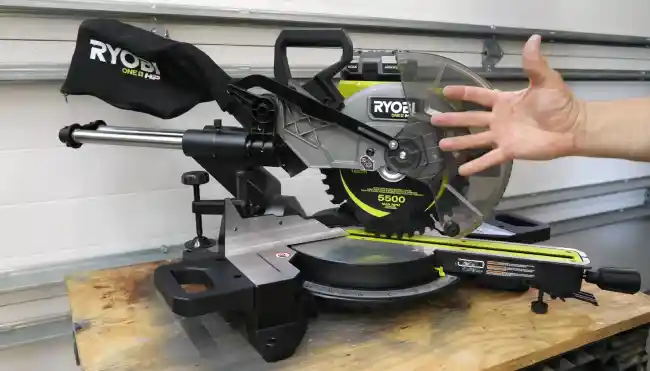
You’ll find that Ryobi’s miter saw is a reliable tool for achieving accurate cuts and handling large structures. Their ergonomic design ensures comfortable usage, and with a comfortable weight, it’s relatively lightweight compared to other miter saws available in the market.
Can I use Ryobi miter saws for professional woodworking projects?
Ryobi’s miter saws can be suitable for professional woodworking projects, depending on the specific needs of your project and your skill level. While they may not offer the same power level as higher-end brands like Metabo, Ryobi saws can still get the job done effectively.
How good are Metabo Mitre saws?
Metabo, a German firm with a long history of excellence, offers an impressive range of miter saws. One standout model is the KGS216M, which falls between their ultra-portable small saws and high-capacity benchtop workhorses.
Metabo’s miter saws are known for their reliability, precision, and durability. They’re built to withstand the demands of commercial woodworking projects, providing accurate and clean cuts every time.
With features like adjustable bevel angles, laser guides, and dust collection systems, these saws offer convenience, efficiency, and exceptional performance.
Which miter saw offers better precision and adjustability?
The Metabo miter saw may be the better choice if precision and adjustability are important. These miter saws are known for their accuracy and ability to make intricate cuts. The adjustable base on these saws allows for precise cutting angles, giving you more control over your projects.
With a Metabo miter saw you can confidently tackle any project that requires precision and adjustability.
Metabo or Ryobi Miter Saw: Choose the Perfect Saw for Your Woodworking Projects
When investing in a miter saw for woodworking projects, consider a variety of factors, such as motor power, cutting angles, dust collection, safety features, and price point.
Metabo excels in motor power, cutting angles, dust collection, precision, plunge cuts, blade size, and safety features, making it an ideal choice for heavy-duty projects. Conversely, Ryobi’s lighter weight, portability, and budget-friendly price make it more suitable for DIY enthusiasts and lighter-duty tasks.
Ultimately, choosing between the two brands will depend on your specific woodworking needs and preferences. So take your time, research carefully, and choose the miter saw that’s the best fit for you.

